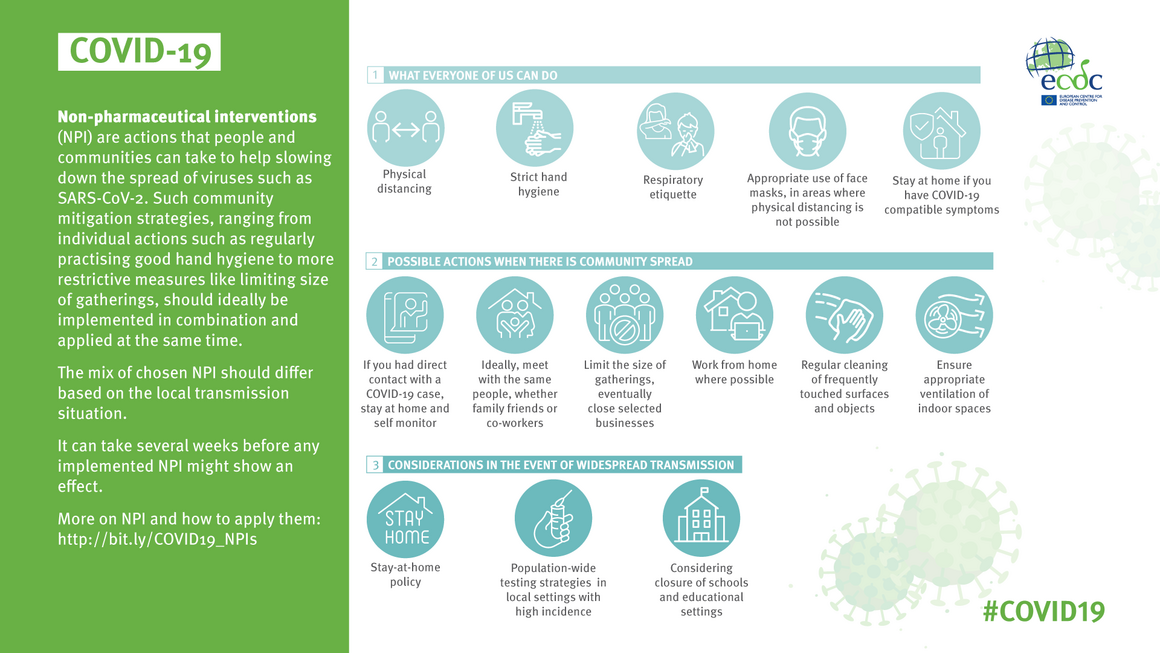Non-pharmaceutical interventions against COVID-19

Last update: 7 March 2023
Non-pharmaceutical interventions (NPIs) are public health measures that aim to prevent and/or control SARS-CoV-2 transmission in the community. Vaccination against COVID-19 can assist in limiting transmission, and is the most important measure to prevent severe disease and death. NPIs are important interventions to consider, particularly in the event of the emergence of a new SARS-CoV-2 variant of concern that causes more severe disease.
General considerations on NPI to control COVID-19
- NPIs have played a significant role in reducing transmission rates and the impact of COVID-19 in European Union and European Economic Area (EU/EEA) countries.
- Most NPIs can have a negative impact on the general well-being of people, the functioning of society, and the economy. Therefore, their use should be timebound, their effectiveness regularly evaluated, and their adjustments guided by data on the local epidemiological situation.
- Specific recommendations should be tailored to protect the most vulnerable, such as enhanced surveillance and infection prevention and control practices in settings that host high-risk individuals, such as long-term care facilities.
- In countries/regions/municipalities/communities where sustained control of SARS-CoV-2 has been achieved, as documented by surveillance, NPIs can be relaxed.
- In countries/regions/municipalities/communities where the public health objective is to control transmission, the authorities should ensure that NPIs are understood and correctly applied by the population. NPIs to be considered include maintaining physical distance in all settings, ensuring sufficient ventilation of closed spaces with fresh air, rigorous hand hygiene and respiratory etiquette, and the wearing of appropriate face masks in crowded indoor places.
Decision-makers responsible for implementing population- and/or environmental-level NPIs, either at local or national level, should consider the advice/evidence below when deciding on the combination of measures. ECDC's guidelines for the implementation of non-pharmaceutical interventions against COVID-19 , published in September 2020, assessed the evidence available at the time of publication for the available options for NPIs in various epidemiologic scenarios. It addresses implementation issues, including potential barriers and facilitators. This can be of support when looking to tailor NPIs to the epidemiological situation, as well as level of vaccination coverage in a population.
Considerations in the event of community transmission
During phases when there are high rates of community transmission of SARS-CoV-2, the following may be considered:
- Promoting and facilitating physical distancing in all settings is an effective NPI to reduce the levels of SARS-CoV-2 transmission in the community.
- Advising the population to voluntarily self-isolate if experiencing COVID-19 compatible symptoms is an essential measure for reducing the number of secondary infections. This should be linked to easy access to testing.
- Promoting teleworking where possible can reduce the risk of outbreaks in the workplace.
- Limiting the size of indoor and outdoor gatherings decreases the likelihood of SARS-CoV-2 spreading to large numbers of people. Such a measure is more effective if implemented consistently.
- Proactive school closure is not recommended as an effective COVID-19 containment strategy, because the impact of school closure on children’s education, families’ economies, and on society as a whole is significant and well-documented.
- Environmental measures, such as appropriate ventilation of indoor spaces, can lower the risk of disease transmission in the community. Such measures are particularly relevant in healthcare settings to reduce nosocomial transmission and infection of healthcare workers. Additionally, regular cleaning of frequently touched surfaces can reduce transmission of several infectious diseases.
Addressing NPI compliance
- Support for NPIs has varied considerably across countries and in different population groups within the same country: what works to promote safe behaviour in one city, country, culture, or population may be ineffective or otherwise sub-optimal in another. Several EU/EEA countries have therefore been working to incorporate behavioural insights into their COVID-19 response work, using ongoing assessments of public attitudes, behaviour, and beliefs within their own populations. Innovative means to monitor compliance with recommended NPIs were also used.
- Risk Communication and Community Engagement (RCCE) are core public health interventions contributing to emergency response. RCCE is instrumental in achieving results across all the main areas of response, from laboratory testing, contact tracing and isolation, to treatment and preventive/protective measures, including vaccination and implementation of NPIs. For all these measures, successful implementation is dependent on support from affected individuals and communities. The COM-B model is a behaviour change theory based on the common-sense idea that a given behaviour occurs when both the capability and opportunity are present, and when the individual concerned is more motivated to adopt that behaviour than any other. Systematically applying such models can optimise the effectiveness of strategies promoting NPIs.



